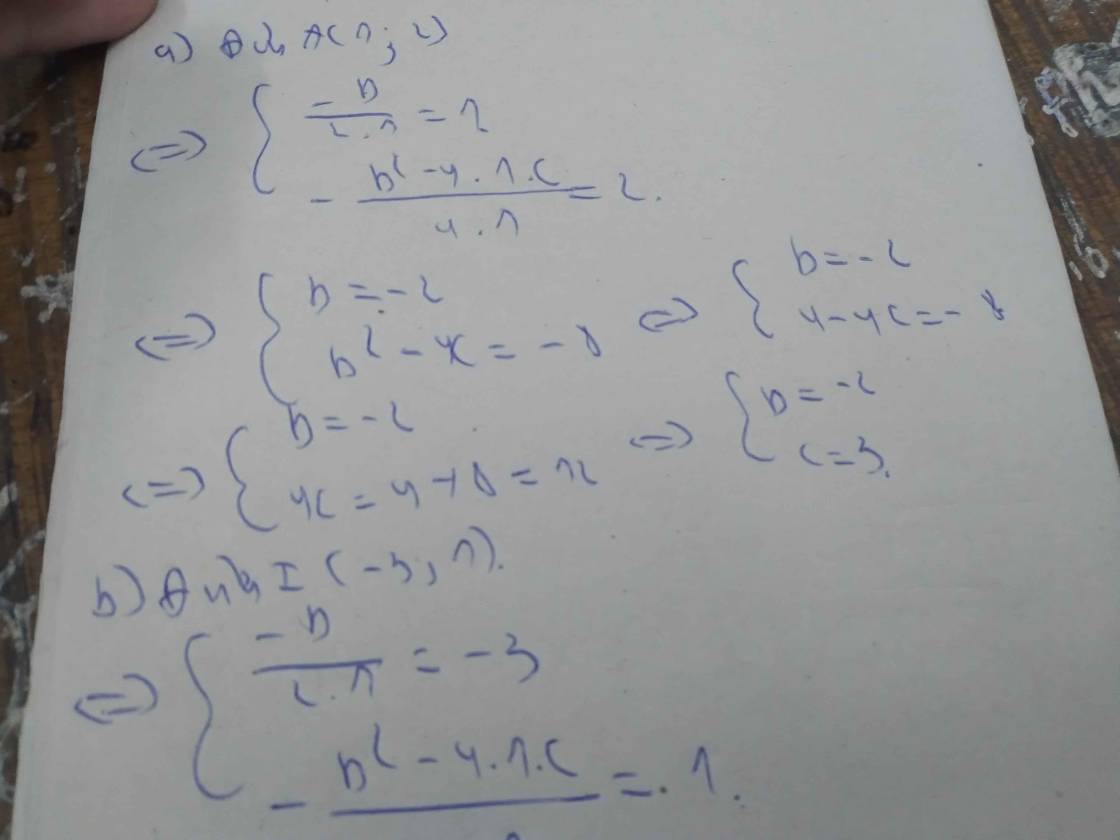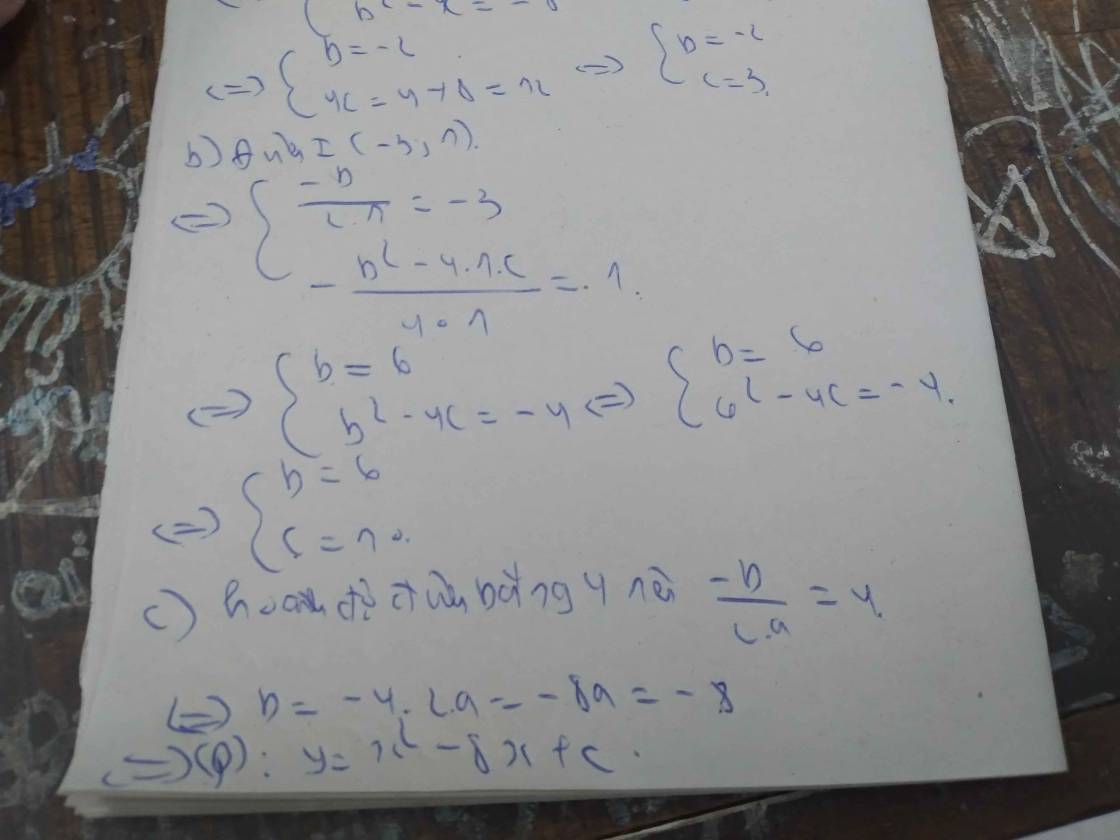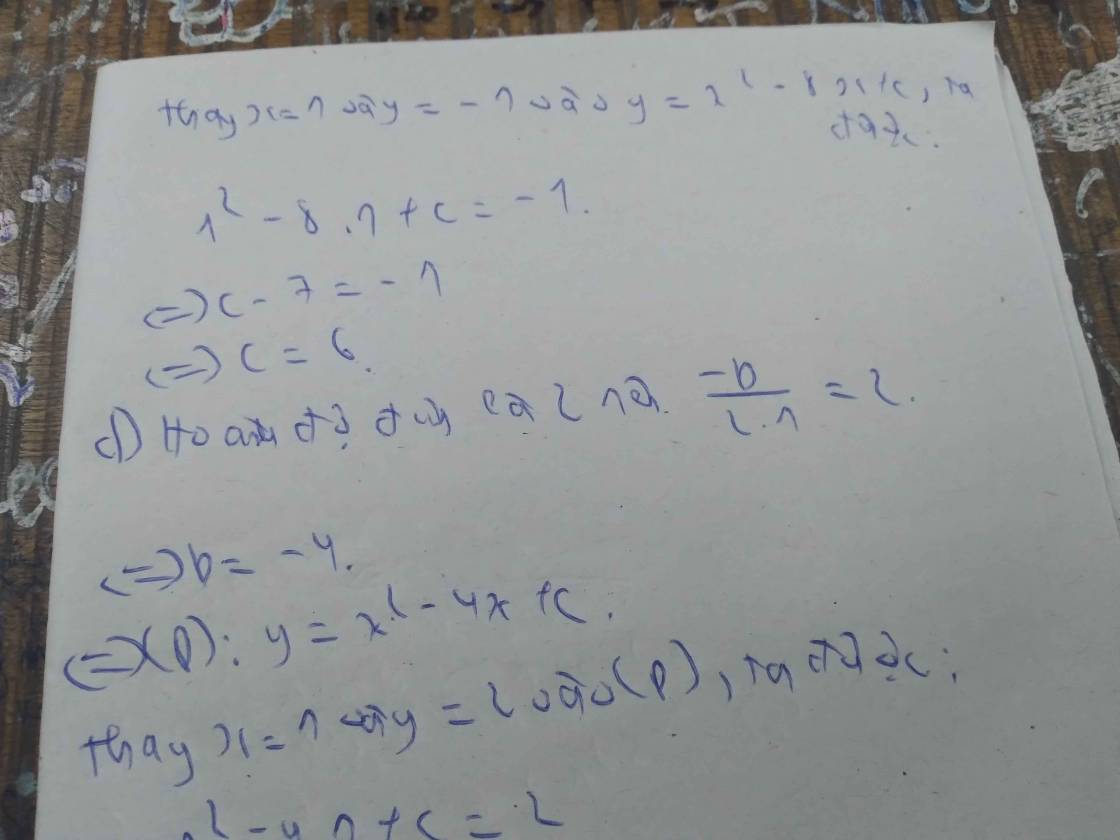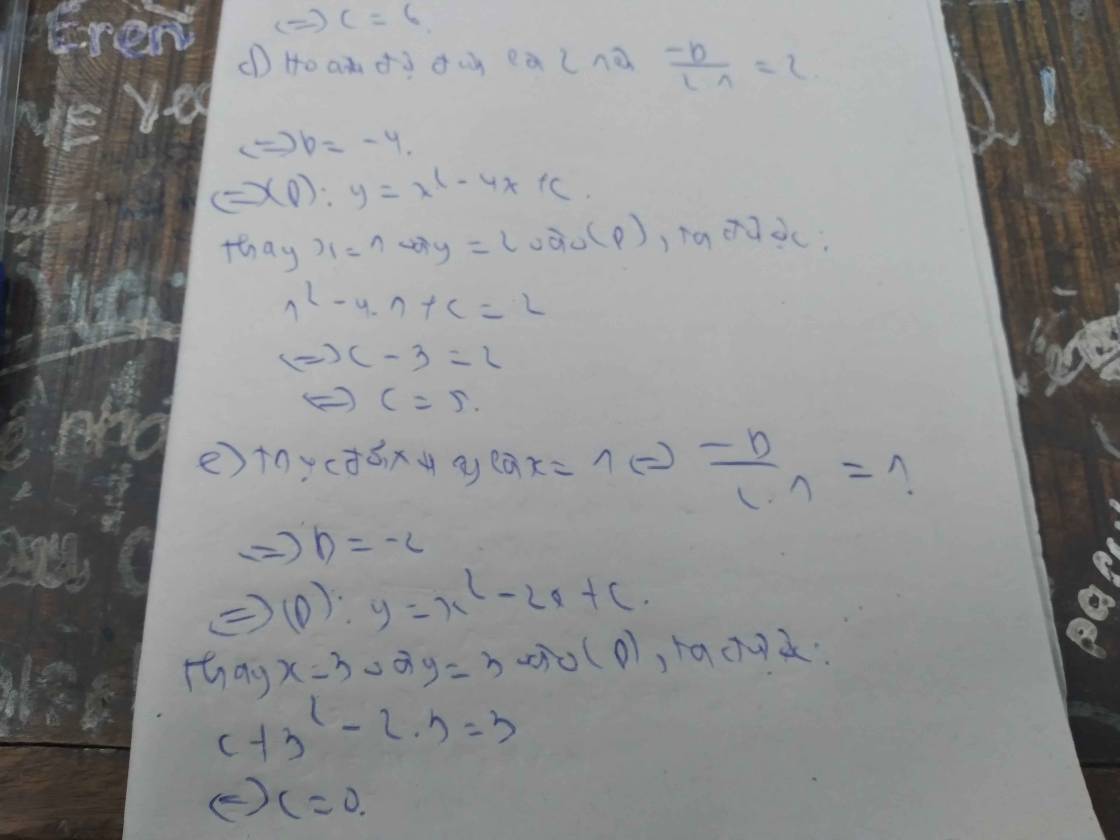Hãy nhập câu hỏi của bạn vào đây, nếu là tài khoản VIP, bạn sẽ được ưu tiên trả lời.

Đáp án D
Yêu cầu bài toán
⇔ − b 2 + 4 ac 4 a = 3 4 ⇔ − 1 + 4 m 4 = 3 4 ⇔ 4 m = 4 ⇔ m = 1

a: Thay x=3 và y=0 vào (1), ta được:
\(6-3m=0\)
hay m=2

a: vecto AB=(2-m;-2)
vecto AC=(-4-m;2)
Để A,B,C ko thẳng hàng thì \(\dfrac{2-m}{-4-m}< >\dfrac{-2}{2}=-1\)
=>2-m<>m+4
=>-2m<>2
=>m<>-1
b: Tọa độ trọng tâm là:
\(\left\{{}\begin{matrix}x=\dfrac{m+2-4}{3}=\dfrac{m-2}{3}\\y=\dfrac{3+1+5}{3}=3\end{matrix}\right.\)
Để M nằm trên d thì \(\left\{{}\begin{matrix}\dfrac{m-2}{3}=t+1\\5-2t=3\end{matrix}\right.\Leftrightarrow\left\{{}\begin{matrix}t=1\\m-2=3\cdot2=6\end{matrix}\right.\Leftrightarrow m=8\)

a: vecto AB=(2-m;-2)
vecto AC=(-4-m;2)
Để A,B,C ko thẳng hàng thì \(\dfrac{2-m}{-4-m}< >\dfrac{-2}{2}=-1\)
=>2-m<>m+4
=>-2m<>2
=>m<>-1
b: Tọa độ trọng tâm là:
\(\left\{{}\begin{matrix}x=\dfrac{m+2-4}{3}=\dfrac{m-2}{3}\\y=\dfrac{3+1+5}{3}=3\end{matrix}\right.\)
Để M nằm trên d thì \(\left\{{}\begin{matrix}\dfrac{m-2}{3}=t+1\\5-2t=3\end{matrix}\right.\Leftrightarrow\left\{{}\begin{matrix}t=1\\m-2=3\cdot2=6\end{matrix}\right.\Leftrightarrow m=8\)

Phương trình hoành độ giao điểm:
\(x^2+2x-m+1=x+1\)
\(\Leftrightarrow x^2+x-m=0\left(1\right)\)
\(\left(d\right),\left(P\right)\) cắt nhau tại hai điểm phân biệt khi phương trình \(\left(1\right)\) có hai nghiệm phân biệt
\(\Leftrightarrow\Delta=4m+1>0\Leftrightarrow m>-\dfrac{1}{4}\)
Phương trình \(\left(1\right)\) có hai nghiệm phân biệt \(x=\dfrac{-1\pm\sqrt{4m+1}}{2}\)
\(x=\dfrac{-1+\sqrt{4m+1}}{2}\Rightarrow y=\dfrac{1+\sqrt{4m+1}}{2}\Rightarrow A\left(\dfrac{-1+\sqrt{4m+1}}{2};\dfrac{1+\sqrt{4m+1}}{2}\right)\)
\(x=\dfrac{-1-\sqrt{4m+1}}{2}\Rightarrow y=\dfrac{1-\sqrt{4m+1}}{2}\Rightarrow B\left(\dfrac{-1-\sqrt{4m+1}}{2};\dfrac{1-\sqrt{4m+1}}{2}\right)\)
\(AB=8\Leftrightarrow\sqrt{8m+2}=8\Leftrightarrow m=\dfrac{31}{4}\left(tm\right)\)
2.
a, \(AB=2\sqrt{5},BC=5\sqrt{10},CA=\sqrt{170}\)
\(AM^2=\dfrac{AB^2+AC^2}{2}-\dfrac{BC^2}{4}=\dfrac{65}{2}\Rightarrow AM=\dfrac{\sqrt{130}}{2}\)
b, \(\left\{{}\begin{matrix}x_D-4-2\left(x_D-2\right)+4\left(x_D+3\right)=0\\y_D-3-2\left(y_D-7\right)+4\left(y_D+8\right)=0\end{matrix}\right.\)
\(\Leftrightarrow\left\{{}\begin{matrix}x_D=-4\\y_D=-\dfrac{14}{3}\end{matrix}\right.\)
\(\Rightarrow D\left(-4;-\dfrac{14}{3}\right)\)
c, \(\left\{{}\begin{matrix}\overrightarrow{AA'}=\left(x_{A'}-4;y_{A'}-3\right)\\\overrightarrow{BC}=\left(-5;-15\right)\\\overrightarrow{BA'}=\left(x_{A'}-2;y_{A'}-7\right)\end{matrix}\right.\)
\(AA'\perp BC\Leftrightarrow\left\{{}\begin{matrix}\overrightarrow{AA'}.\overrightarrow{BC}=0\left(1\right)\\\overrightarrow{BA'}=k\overrightarrow{BC}\left(2\right)\end{matrix}\right.\)
\(\left(1\right)\Leftrightarrow-5\left(x_{A'}-4\right)-15\left(y_{A'}-3\right)=0\Leftrightarrow x_{A'}+3y_{A'}=13\)
\(\left(2\right)\Leftrightarrow\left\{{}\begin{matrix}x_{A'}-2=-5k\\y_{A'}-7=-15k\end{matrix}\right.\Leftrightarrow3x_{A'}-y_{A'}=-1\)
\(\left\{{}\begin{matrix}x_{A'}+3y_{A'}=13\\3x_{A'}-y_{A'}=-1\end{matrix}\right.\)
\(\Leftrightarrow\left\{{}\begin{matrix}x_{A'}=1\\y_{A'}=4\end{matrix}\right.\Rightarrow A'\left(1;4\right)\)

A thuộc y=x+2 nên A(x;x+2)
Theo đề, ta có:
\(\left\{{}\begin{matrix}x=\dfrac{2m}{2}=m\\x+2=-\dfrac{\left(2m\right)^2-4\left(m+3\right)}{4}\end{matrix}\right.\Leftrightarrow\left\{{}\begin{matrix}x=m\\x+2=-\dfrac{4m^2-4m-12}{4}\end{matrix}\right.\)
\(\Leftrightarrow\left\{{}\begin{matrix}x=m\\x+2=-m^2+m+3\end{matrix}\right.\Leftrightarrow-m^2+m+3-2=m\)
=>-m^2+m+1-m=0
=>1-m^2=0
=>m=1




Ta tìm đỉnh của parabol:
Suy ra m=1.
Chọn D.